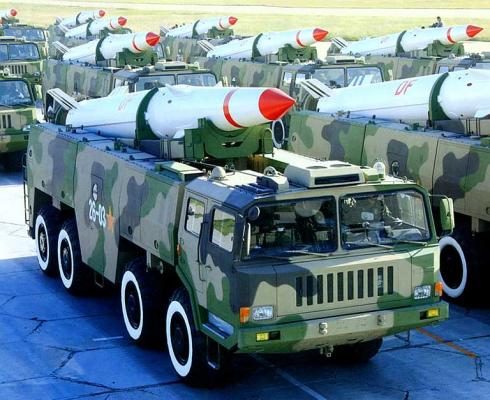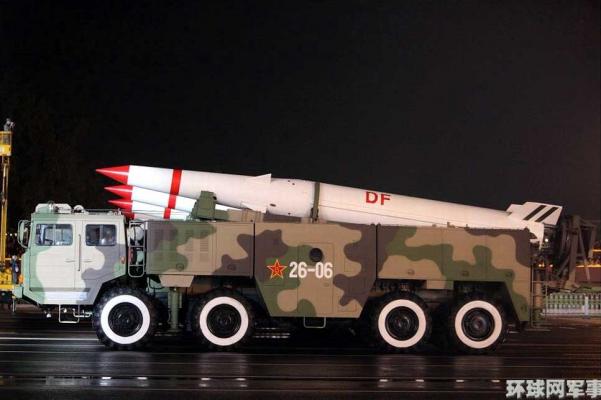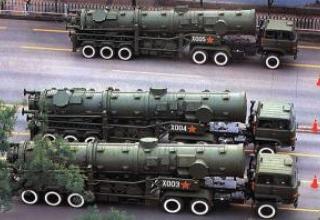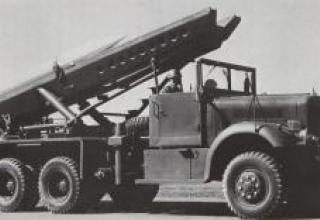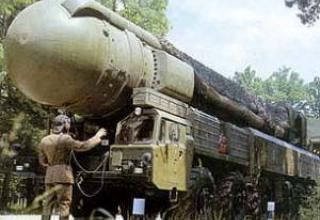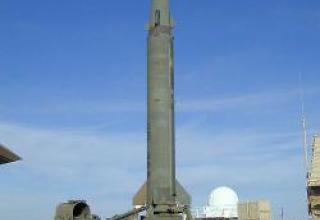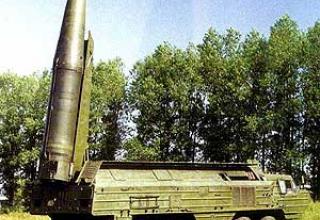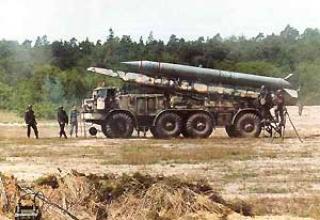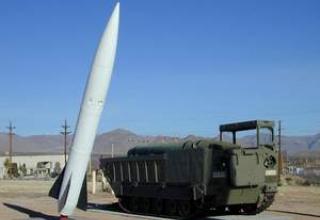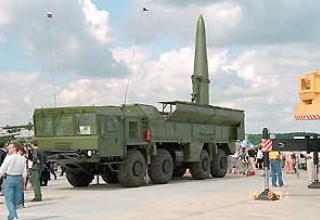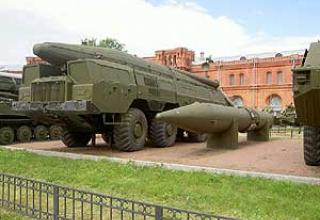Operational-tactical missile system DF-15 (Dong Feng-15) is designed to deliver missile strikes on especially important small and flat targets of the enemy: firepower, aircraft and helicopters at airfields, command posts and communication centers, the most important objects of civilian infrastructure.
The DF-15 missile defense system (export name: M-9; NATO classification: CSS-6) was developed by the Chinese Academy of Rocket Motor Technology (ARMT, also known as the Fourth Aerospace Academy). The development of the complex began in 1985, the first test launch took place in June 1987. The complex was first presented in 1988 at the Defence Systems Exhibition in Beijing. Presumably DF-15 was adopted by the Second Artillery Corps of the People's Liberation Army of China (PLA) in 1989.
The complex became known during a series of tests conducted by the PLA as a demonstration of force in 1995-96 in the waters of the Strait of Taiwan. The first series of launches took place on June 21-23, 1995. During the tests, six DF-15 missiles were launched from the position area in Fujian Province, five of which successfully hit targets in neutral waters northwest of Taiwan. The second series of firing took place in 1996. - Two missiles launched in the early morning of March 8, 1996 almost simultaneously hit targets in the sea to the southwest and east of Taiwan. To demonstrate the capabilities of the complex on the same day, with a short pause, the DF-15 rocket launcher, which had already performed the launch, was reloaded and reused to launch the missile. The fourth rocket was launched on March 12 and successfully hit the target area. During this exercise, 20 to 30 launchers were deployed with support and support facilities.
In 2007, the U.S. Congress Defense Report cited 70-80 deployed launchers and 300-350 DF-15 missiles. Official Chinese sources indicate the existence of two missile brigades with fewer than 100 APs and 360 combat and training missiles. The complex is being actively upgraded: the control system is being improved to improve accuracy of firing, and new versions of the missile's combat equipment are being developed. The first variant, designated DF-15A, has been replaced by DF-15B and DF-15C.
The information about export deliveries of DF-15 (M-9) is rather contradictory. According to some data, due to restrictions imposed by the Missile Technology Nonproliferation Control Regime, the complex has never been exported to other countries, while others have been exported in large quantities to Pakistan, Iran, Egypt and Syria. It is possible that the confusion arose due to the external similarity of the DF-15 (M-9) complex to the earlier DF-11 (M-11).
Composition:
The launcher (PU) of the DF-15 complex is placed on the wheel chassis of TAS5450 or WS2400 and is designed for transportation of missiles, prelaunch preparation, aiming and launching the missile. PU made on the TAS5450 chassis (wheel arrangement 8x8, payload 25t) has an opening roof of the missile compartment. The version based on WS2400 (wheel arrangement 8x8, payload 22t) has no roof, to protect the missile from precipitation, dust and dirt are used special covers (see photo). PU provides automatic determination of its coordinates with the help of GPS receiver and data exchange with all control elements. Top-geodetic and engineering preparation of launch positions is not required during rocket launches. On the chassis are located: an arrow with mechanisms for lifting and fixing the rocket, drives for opening and closing the roof, the launch table with guidance mechanisms and gas reflector. In the combat position, the unit is supported by four jacks, which are operated by the hydraulic system. The first pair is located between the first and second axles, and the second is behind the fourth axis of the chassis. Prior to launch, the missile is positioned vertically by means of a boom and remains in an upright position on the launch table until launch. The prelaunch preparation time is 30 minutes. The processes of checking the performance and maintenance of the rocket systems and the launcher are automated.
DF-15 missile is a single-stage solid fuel missile with a detachable head end (MS).
There are three options for the DF-15 missile (see diagram):
- DF-15A is a basic version;
- DF-15B is an upgraded version with increased pointing accuracy;
- DF-15C - a missile with a new HF, presumably having an extended range (see photo).
The weight of the missile head unit is up to 500 kg. As a warhead, the DF-15 can carry a 50-350kt nuclear charge or be equipped with various types of non-nuclear warheads. Information on the availability of blast, thermobaric and cassette warheads has been published. A cassette warhead is equipped with incendiary or cumulative-shrapnel submunitions. Battle units designed to remotely mine the terrain are under development, as well as RF with electromagnetic transmitters to interfere with radio communications in order to disrupt enemy communications and control systems.
Gas rudders located in the output section of the rocket engine nozzle are used to control the missile at the starting point of the trajectory. In the descending section of the trajectory, after the head part is separated, its flight speed reaches 6M. This section of the trajectory is controlled by a gas-jet correction system. At the DF-15B missile for the same purpose in dense layers of the atmosphere are used aerodynamic all-terrain rudders on the hull of the RF (see photo 1, photo 2). The high flight speed and detachable head end make the interception of the DF-15 extremely difficult using any of the existing missile technology.
The DF-15B missile is equipped with a free inertial fully digital control system with an onboard computer. The first variants of the DF-15A had a circular deflection of 300-600m, while further control system improvements have reduced the CWO to 150-500m. According to the developers' information, the work being done to equip the DF-15 missile with a satellite guidance system and a new inertial control system on ring laser gyroscopes allowed increasing the guidance accuracy up to 35-50m.
The complex can be transported by railway without additional disassembly.
See the DF-15 image gallery of the OTRK.
Characteristics:
| Range of fire, km | 600 |
| Starter weight,kg | 6200 |
| Dimensions, mm: - length - diameter |
9100 1000 |
| Starter weight, kg | 6200 |
| Weight of combat unit, kg | 500 |
| KVO, m | 150-500 (35-50 m in later versions) |
| Pre-start preparation time, min. | 30 |
Testing:
As of 01.01.1950, the factory batch of 230 shells was completed and sent to the Pavlograd test site.
In November 1949, pre-factory tests of 34 shells were carried out together with the fuse B-377 during which cases of missiles were revealed.
Special tests carried out to determine the causes of deficits showed that the most probable cause was an increased release of unburned reactive charge particles at the end of the active section of the trajectory.
In order to eliminate this phenomenon, in December 1949 a bench-top refinement of the engine was started with regard to aperture enhancement and ensuring that the powder charge was fixed in the chamber. After the end of the bench work and experimental firing for checking the reinforced aperture, the factory batch of projectiles was to be equipped with modified apertures on site and presented for factory tests in February 1950.
Sources:
- DF-15 / M-9 (CSS-6) Short-Range Ballistic Missile /www.sinodefence.com/
- CSS-6 (DF-15/M-9) /www.missilethreat.com/
- DF-15B short-range ground-to-ground missile
- PLA Ballistic Missiles
